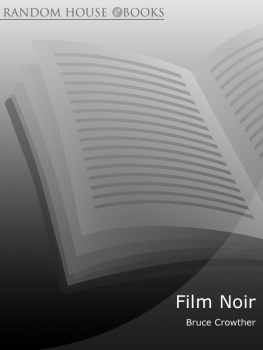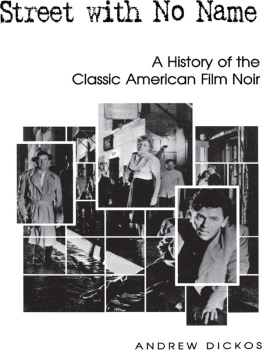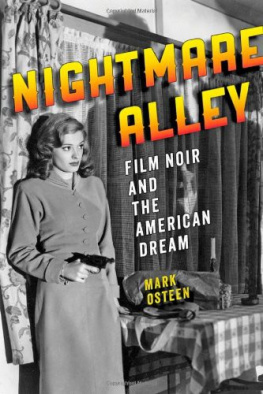BOOKS BY NICHOLAS CHRISTOPHER
Fiction
Veronica (1996)
The Soloist (1986)
Poetry
5 (1995)
In the Year of the Comet (1992)
Desperate Characters: A Novella in Verse & Other Poems (1988)
A Short History of the Island of Butterflies (1986)
On Tour With Rita (1982)
Nonfiction
Somewhere in the Night: Film Noir & the American City (1997)
Anthologies (as editor)
Walk on the Wild Side: Urban American Poetry Since 1975 (1994)
Under 35: The New Generation of American Poets (1989)
THE FREE PRESS
A Division of Simon & Schuster Inc.
1230 Avenue of the Americas
New York, NY 10020
www. SimonandSchuster.com
Copyright 1997 by Nicholas Christopher
All rights reserved, including the right of reproduction in whole or in part in any form.
THE FREE PRESS and colophon are trademarks of Simon & Schuster Inc.
Manufactured in the United States of America
10 9 8 7 6 5 4 3 2 1
[CIP DATA IS AVAILABLE]
ISBN 0-684-82803-0
ISBN 978-0-6848-2803-9
eISBN 978-1-4391-3761-1
I am most grateful to John Ashbery, Paul Vlachos, James Byerley, Robert Polito, and Monty Arnold for the often rare videocassettes, magazines, and books, not to mention the hot tips, which they generously passed on to me. And I would like to thank my wife, Constance Christopher, who over the years watched literally hundreds of films noirs with mewell beyond the call of dutyand offered insights and observations at every turn that have been of enormous help to me in writing this book.
As a boy, I was never afraid of the dark. Shadows and light intrigued me. As far as I was permitted in those days of relatively safer streets, I liked to go for walks at night. My bicycle was fitted with both a strong headlamp and a red rear light, powered by a generator on the back tire, as well as assorted reflectors. I passed hours star-gazing on the roof. I even preferred attending night games at Yankee Stadium. A night owl then, as now, at one point I built my own shadow play theatera crude but functional designfor which I concocted a series of one-act plays that were later performed with friends. My extracurricular reading before age twelveoften accomplished well after hours, with the help of a flashlightconsisted mostly of pulp mysteries and comic books, foremost among the latter the nocturnal, Gothic, subterranean Batman of the late 1950s and early 1960s. When it came to movies, my tastes ran to the B-variety: police thrillers, detective stories, and crime melodramas. Ditto the television fare that captured my attention; and in retrospect, early television shows like Lineup, Dragnet, and even Perry Mason, black and white in the starkly lit fashion of the day, intensely urban and nocturnal, look very dark, indeed.
I was born in February 1951 in New York City, in the dead of winter, at the height of the Korean War, the Cold War, and the McCarthy era. It was also the dawn of the Atomic era, and of the faceless, white-collar variety of organized crime, with its corporate structurebuying up banks and sometimes entire municipalitiesbut still relying on subcontractors of a gaudier sort, like Murder Incorporated, for raw street muscle. It was the heyday of labor unions and bebop jazz, and it was also the apex of the classic film noir era. In the month of my birth alone, my parents and their fellow moviegoers across America had the opportunity, at neighborhood theaters, to see the first runs of such seminal noir films as Cause for Alarm, The Second Woman, and The Killer That Stalked New York, as well as The Enforcer and Cry Danger, which premiered in New York just days before my birthday. Twenty more films noirs would be released by the major Hollywood studios before the end of 1951. Between January 1950 and December 1952, seventy-four such films appeared on American movie screensa staggering number by todays standards.
My own connection, through relatives, to some of the 1951 phenomena to which I have alluded seems tenuous, blurred by the passage of time: for example, aside from the Strontium 90 in my bone marrow from the milk of 1950s cows exposed to atmospheric testing of atomic bombs, my most visceral link with the dawn of the Atomic Age would seem to be the fact that my father, fulfilling his wartime obligations, toiled in Chicago as a young engineer on the Manhattan Project; and my grandfather, it happens, stumbled onto the scene of one of Murder Incorporateds most infamous hits, seconds after it occurred, in the barbershop of a midtown hotelan event he spoke of, with uncharacteristic amazement and fear, to the end of his life. How and to what extent the hysteria of the Cold War and the paranoia of the McCarthy witch hunts invaded my budding psyche Ill never know. What is available for me to see today, depicted with harsh clarity in the films noirs of those times, are the intricate surface textures and the submerged turmoil, the highly magnified inner and outer manifestations, of the urban life that surrounded me as a child. Unsafe, unsanitized, unaccommodating, film noir, now more than ever, appears to me to be the fugitive footage of postwar America. It is the negative from which all true prints would later be rendered, in which the conflation of the twin shocks (or ever-ramifying nightmares) of a near-apocalyptic world war and rapid-fire American urbanization would be captured and delineated, painfully and unswervingly, for all time.
I was twenty-two years old the first time I saw a film noir and knew it to be such. The film was Out of the Past, and I watched it in a theater in Paris, France, in the summer of 1973. This was a tumultuous time, not just in the United States, but also in France, where massive student and labor unrest had erupted that spring. Barricades blocked the steep streets near the Sorbonne, tear gas bit the air, and at particularly explosive city arteries, rubber bullets were being fired into crowds of demonstrators. Still, people were going to work, eating, drinking, making love, and attending the cinema. Footloose, zigzagging southward, fresh out of college, I was doing all of the former except working. The cinema was low on my list of activities, and it was quite by chanceas seems altogether appropriate nowthat I found myself watching Out of the Past on a hot July night.
The theater was located on a narrow sidestreet off the Rue de Rennes in a working class district. Surrounded by tire shops, garages, and a sausage factory, it was improbably named The New Yorker, the letters glowing in indigo neon on the small, crooked marquee. Made in Hollywood and released in the United States in 1947, Out of the Past had been playing at The New Yorker for three weeks to standing-room-only houses as part of an ongoing Festival du Film Noir Americain. It was directed by Jacques Tourneur (an American) and it starred Robert Mitchum, Kirk Douglas, and Jane Greer. A French friend who happened to be a medical student, and who had seen the film three times, advised me solemnly to smoke some opium before I attended a screening. Not a drug with which I had experience, I was nonetheless game, and he provided me with a sample (and his girlfriends Pyrex pipe) that I shared with two other friends who immediately lost interest in going to the cinema and, after providing me with explicit, and bewildering, directions, instead drifted off to a party.
So I found myself alone on a hard seat in the rear of a packed, smoky theater (with posters of the Manhattan skyline in the lobby), where one could hear a pin dropso reverential, so congregation-like, was this chain-smoking French audienceand watched
Next page









